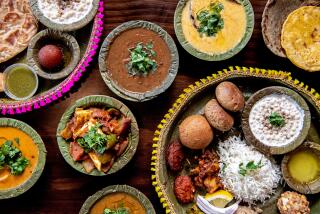DAL : The Odder Dals
- Share via
Other dals you can find in an Indian market include familiar favorites like blackeyed peas (cowpeas) and split peas. The blackeyed pea originated in Africa, where wild varieties are still found. Oddly, in modern India it’s called lobia or lobhia , a name that comes from Greek, while rajma , its original Indian name, is now applied to kidney beans. Indian cooks boil blackeyed peas in the usual way and also grind them into flour for making pancakes.
By the way, split peas, called matar in India, are a different species from the garden peas we eat as a fresh vegetable. Technically split peas are Pisum arvense, or field peas. They originated in Italy but reached India long ago, at least by 1500 B.C. Indian cooks often make field peas into little croquettes like felafel.
The odder dals are ones you might not find even in a well-stocked Indian market. You have a middling chance of coming across moth , a native Indian bean very similar to moong and cooked much the same. Indian snack shops sell a sort of spicy cocktail mix called dal moth , made from fried moth beans and garbanzo vermicelli.
Val or lablab , otherwise known as butter bean, is harder to find in markets, but it is sometimes grown in this country as an ornamental plant because of its sweetpea-like flowers. Nurseries know it as Dolichos lablab or hyacinth bean. The beans take a long time to cook and are difficult to digest, but they’re popular among Indian vegetarians because their flavor and texture are considered to resemble meat.
*
K ulathi , otherwise known as horse gram or Madras gram, is a small, reddish-brown bean related to val which is eaten fresh or dried; it looks like a flattened pea. (In an Indian context the word gram means a pea or bean-- urad dal is also called black gram, moong dal is green gram. It’s not a native Indian term but the Portuguese word grao , meaning grain, which somehow acquired this meaning in the early days of the East India trade.)
Rice bean, known as sutari , meth or (in Nepal) shiltong , is a cousin of moong . It’s an unprepossessing little thing, but it may turn out to be of some importance some day because it has the highest calcium content of any bean.
Bara sem , otherwise known as nishpava or bhatabans , is an Asian cousin of the jackbean, a moderately obscure native of the New World tropics. It’s sometimes called swordbean because of the shape of its large pods. You won’t see it in a market in this country--it’s only eaten as a green vegetable. That’s because ripe swordbeans are, well, just the tiniest bit poisonous.

